Our Folded Hands
Women helping Women. Reaching out to the Sister who still suffers. Helping each other through the Good times and the Difficult times. To get to the SOBER way of life, One Day at a Time.
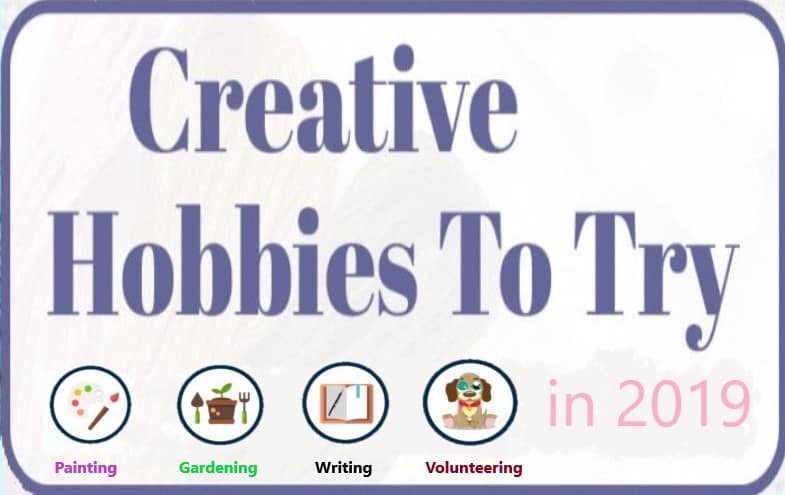
Hobbies can Help and Heal You!
Nobody can escape the occasional feeling of stress, but we can definitely find out ways to reduce that annoying nagging feeling of anxiety. In addition to eating well, sleeping, and practicing other self-care, there are also a number of hobbies that can reduce stress, and these extend beyond the stereotypical activities such as yoga and mediation —although those definitely work! If you’re looking to incorporate more into your life than just work and your social life, you might want to consider involving yourself in a hobby that is not only enjoyable, but that can help reduce your overall stress levels. Hobbies are helpful in relieving our Stress and anxieties. They can also help us to get outside ourselves and get involved with new social groups. Hobbies are a way of reaching our imagination and our creative side. Isn’t it time to see where our imaginations can lead us? What kind of creative fun awaits us in our Sobriety? Share the experience with the friends we make along our journey! All of these Hobbies are based on their author’s opinion, and are given in Hopes that you find Your Creative outlook in your spare time… HAVE SOME FUN, Replace your drinking with Creative Thinking!!!

Jigsaw Puzzles
Uses for Jigsaw Puzzle
Jigsaw puzzles are great hobbies; and they are not just a hobby for children. Men and Women throughout the world today both take advantage of jigsaw puzzles and the hours of fun they can offer. Jigsaw puzzles are becoming more and more popular. Why, because they are an activity that is affordable, relaxing, and educational.
They are a challenge and a very relaxing activity. As you find the pieces and fit them together you feel a sense of satisfaction. After a stressful day or situation, there is nothing like sitting down to an enjoyable hobby; becoming lost in it and leaving the world behind.
When the puzzles are completed some individuals mount them for pictures for their wall putting them in attractive frames. There are so many varied scenes on jigsaw puzzles currently that anyone can find the right puzzle to suit their taste. There are other craft projects suitable to the use of jigsaw puzzles, such as table tops covered with glass or any other furniture for that matter. The uses for jigsaw puzzles, in terms of crafts and decorations are only limited by your imagination. Some people complete the jigsaw puzzles and either trade them or put them away for another day.
Jigsaw puzzles also serve very important educational purposes. Puzzles are commonly used in schools to teach in all areas of education. They are also used for therapeutic purposes in counseling facilities, and mental health facilities to diagnose and treat certain disorders. For example, children who are abused, as part of diagnostic tools, puzzles are used to determine the situation. Schools use them as behavior disorder treatment tools and special education tools to teach and treat the students.
Jigsaw puzzles make a wonderful and lasting gift to a friend or loved one. This type of gift gives the person you care enough to give it to hours of pleasure and enjoyment. A gift such as this can also be used to send a message to your loved one or friend. Puzzles today not only have the gift of existing text and pictures to indicate a message to that special person but you can also have a jigsaw puzzle custom created to you specifications…
Benefits of Jigsaw Puzzles
Jigsaw puzzles have many benefits. They are entertaining and educational, especially for children. Puzzles occupy that time when the children are out of school and have nothing to do. Puzzles are a fun way to teach children, taking the boredom out of learning. It gives them a way to vent energy in a constructive way and is the better for it.
Jigsaw puzzles can be an economical way to bring family and friends together. With costs rising at a frightening rate there is still a way to have fun together without breaking the bank. More than one person working on a puzzle can actually bring about a bonding among those individuals. Jigsaw puzzles can strengthen the family unite while giving them enjoyment and relaxation. In today’s society, when the family spends less time together, doing jigsaw puzzles together is a constructive, wholesome activity that the whole family unit can share.
Jigsaw puzzles can be psychologically beneficial. We live in very stressful times. Those activities that help us relax can only be of benefit. When you sit down to do a jigsaw puzzle it gives you a chance to forget the world around you and get lost in the challenge and accomplishment of the puzzle you are working on. By relaxing, you are giving your body and mind a chance to rest and get caught up. It has been medically proven that stress lowers the immune system, causing us to be more susceptible to disease and illness. By finding ways to relax we are protecting our minds and bodies from the pressures and ills that surround us.
Conclusion
Jigsaw puzzles are currently one of the top of the line activities. They require little knowledge to participate in, and are not an expensive activity. Jigsaw puzzles are hours of fun without breaking the bank. They make a tremendous and versatile gift. Even if you give the gift of a puzzle every year to the same person you need never repeat the gift. This is due to the fact there is such a varied selection of puzzles in appearance, type, size, and style and also because you can have them custom made to your satisfaction. They are a fitting gift for man, woman or child of every taste and preference. Jigsaw puzzles serve many purposes including education, busy work, hobby, therapy, bonding, and gift giving at an affordable price. What more could you ask for? Don’t you just have the overwhelming urge to do a jigsaw puzzle now?
www.discoverahobby.com/learn/Jigsaw_Puzzles
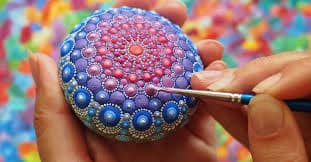
Painting and Watercolors
Why painting is good for you and the reasons why a person should take painting into consideration as a positive activity for a Hobby. One would think that the first reason is because it gives pleasure. Being able to do what one wants provides great satisfaction. After a little more meditation and research from a psychological, social and medical point of view, I have found many more benefits for the physical, mental and spiritual body not only of children but adults as well. Let me summarize the information in this way:
1. Communication
Art makes us more human; it helps us to communicate in a different, personal language. This is a great benefit for all people and mainly for those who have conditions with a lack of communication or problems expressing themselves such as: shyness, autism and other disabilities.
2. Therapy
Painting is an individual activity even in the workshop or classroom; the student enters his/her own world, a world full of possibilities. Stimulus of the creative mind allow the student to positively isolate from reality, which provides a mental rest that lowers stress and generates relaxation and happiness feelings. This is especially significant for people with aggression or nervousness conditions.
3. Self-esteem
Working in a non-competitive, relaxed environment (the teacher plays a major role here) will enable the student come closer to greater personal achievements; this will strengthen his/her individuality and self-esteem. This is especially significant for people with codependency, traumatic conditions and elderly people who need activities that can strengthen their autonomy.
4. Mobility
Learning to hold and handle a brush and/or pencil will help regulate the hand movements and stimulate brain connections at the same time the skill is being developed. In elderly people, painting helps them strengthen their fine motor skill.
5. Concentration and Healing
People who immerse themselves several hours painting or creating something enter a purer area, in a very strong state of concentration; they abstract themselves from their surroundings and time passes by without noticing it. Physical pains fade away; it is almost like entering another dimension without leaving our body. This concentration state is called Alpha; one part of the brain is conscious and the other pulls the unconscious out. There is more creation because a pure energy is transmitted to what´s being created, and we can spend hours without feeling tiredness, pain or other conditions (unlike other activities). This is a state similar to that achieved through praying, meditation, music, aromatherapy, and being in love. There have been cases of miraculous temporary healing in painters, musicians who, when in this state, are able to move their atrophied hands or don´t feel pain when creating or executing. Painters Renoir and Gauguin and musician Andrés Segovia are examples of this.
6. Mental Health
Painting helps us get distracted from our problems; it helps us take anguish out and transform it in something nice, which is given a title. This helps us identify the feelings and increase our expression capabilities. This is especially significant for people with nervousness, mental conditions (like schizophrenia) or people going through an emotional imbalance like a break-up who use the visual expression to achieve catharsis. Adults who learn to paint fight the fear to confront themselves, learn to persevere and are encouraged to create something that belongs only to them, a personal project, unique and enormously satisfying.
7. Brain Activity
Drawing and painting stimulate both the left and right brain hemispheres. The first deals with the rational, logic elements and the second one maximizes our creativity and emotions. Painting is helpful during the growth and development stages of children as well as in adulthood when it is very valuable to fight illnesses like Alzheimer. Painting boosts imagination; the imagination of Alzheimer patients, whose memory starts to vanish, is strengthened.
8. Emotional Intelligence
Emotions are part of the creative world we all have inside. Making those emotions flow through painting helps create harmony between the heart and mind, which leads us to experiment happiness, love, empathy and peace. Within this chaotic world we live, the visualization and relaxation that we obtain through painting are tools that in the long run, benefit our emotional, organic, energetic and spiritual being.
9. Art Appreciation
Practice, understand and talk about art creates a better understanding of it. Individuals see themselves reflected and motivated by the work of others, which also allows us to be a receptor of this type of communication, which dates back to the beginning of human history.
10. Culture
The knowledge that a person can achieve when learning to paint enables him/her to understand human history through art.
11. Fun
Learning how to paint has all the benefits of good entertainment: we laugh, socialize, learn something new, feel motivated to finish what we start, appreciate nature and feel passion for something good..
( You may or may not like painting, but one never knows until they TRY!!!) 😉
www.artblanco.com/blog/55991/11-great-benefits-of-painting
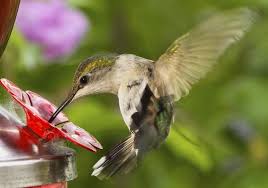
Bird Watching
Bird Watching can be Fun YOU and for the Whole Family!!!
Cultivating mindfulness, or noticing what is happening in the present moment, has all kinds of benefits: If you’re mindful while you’re eating, paying attention to the taste sensations of your food, you can feel more satisfied and even lower your blood
sugar. Being more mindful can make you more productive at work and better at collaborating. If you practice being mindful, it can change your body’s actual response to stress, reducing how much of the stress hormone cortisol is released.
Meditating is the method by which most people tend to try and attain this body-and-mind-improving state. But counting breaths, closing your eyes and concentrating, and other meditations are difficult and sometimes unpleasant—for me and for others. While some people may argue that struggling with meditation is part of the point, it’s also discouraging, and can make a mindfulness practice frustrating. And when something’s frustrating, you’re less likely to set aside time to do it.
Practicing mindfulness specifically through birdwatching can also help your health: In a study published last year in the journal BioScience, scientists from The University of Exeter in England found that when people experience more birds in their daily lives, their mental health improves. They also experienced reduced prevalence and severity of depression, anxiety, and stress. Previous research has found that listening to birdsong contributes to perceived attention restoration and stress recovery.
Some of the benefits, he says, are realized whether or not you’re paying attention to the flapping, chirping, and roosting of your feathered neighbors. “Most people don’t notice the birds around them. But they are seeing them subconsciously. They’re kind of flying across the edge of your vision. They still matter even if you’re not consciously focusing on them, but you gain more of the benefits by watching them.” Birdwatching becomes a true mindfulness practice when you actively look for birds.
Tuning into the songs—or the birds colors or behavior, whichever you choose—can help provide further details that root you in the present. Since mindfulness is partly about “being” in the place you’re in, it helps enhance your mindful experience.
What’s more, most people don’t have to go anywhere to get these benefits. Turning off your phone, or at least putting it away while you’re outdoors, is a simple way to increase your mindfulness of the bird life around you. Give a try , see If it works for you??? 😉
Can’t Knock it til you try it…

Mind and Body exercises
Mind body exercises
The Ultimate Beginner’s Guide to Yoga
If you’ve been thinking about starting up yoga, I can understand why. Yoga benefits your body and mind, and is an unstoppable force of good in the battle against daily stressors.
Without getting too obsessively detailed to the point where you’re falling asleep sitting up, I’ll jump into a brief yoga history. Developing in Northern India thousands of years ago, in literal terms, yoga means “union”.
When you practice yoga, you are essentially looking to bring your physical and mental existence into complete harmony through movement and the willful regulation of your breath. Or you want a killer body. Yoga can do both (multi-tasker).
individual. With that identification comes the empowerment to build on personal strengths and make positive life changes.
This guide will provide you with complete preparation for taking the first steps into your yoga journey, whether you plan to practice at home or in a class setting. Roll out your mat and hang on to your wheatgrass shots – it’s going to be a fun ride.
Stress Management
Life can be stressful. It’s not really supposed to be, but nevertheless, it is. When things happen that are out of your control, or you just need a serious mental break, try yoga.
In this study, a group of 24 self-described emotionally distressed women were chosen to participate in a three month yoga program. When the trial was completed, every single one of them showed massive improvements in levels of cortisol (stress, less anxious and less tired. Yoga gives us a break by letting us focus only on ourselves, and the mental benefits that come along with that are staggering.
Anxiety Relief
Around 40 million adults in the United States alone suffer from some form of temporary or long-term anxiety. Don’t fret, it only takes two months of regular yoga practice twice a week to significantly lower your anxiety levels.
Yoga focuses, once again, on mindfulness. Yoga focuses on the current moment. When we are anxious, we are worried about what might be. Yoga doesn’t allow mind space for the future, thereby whisking away anxiety during practice.
Yoga has also proven sufficient in helping to treat those with PTSD. What more could you ask from an exercise?
Fight Depression
1. Set the Foundation and Open to Grace
This principle asks the student to be in the present moment when beginning their yoga practice. You must be open and receptive to your practice before asking your body for muscle energy. Basically, live in the moment guys. Keep your mind and your body on your mat.
2. Muscle Energy
The muscle energy principle asks for your outer body (skin and bones), to come into harmony with your inner (organs and muscles). This is not as stupid as it sounds. Making every part of your body to work together is what yoga is all about and that is all muscle energy is asking for.
3. Inner – Expanding Spiral
This principle asks for a widening spiral – or widening the back of the body through stretches and breathing. This creates further receptiveness and openness during your practice.
4. Outer – Contracting Spiral
The contracting spiral consists of poses that asks our body to tone, and our minds to strengthen. During this part of your practice, you’ll focus on narrowing the back of your body while toning the front. You’ll add muscle and power to your shoulders and hips.
5. Organic Energy
Organic energy is simply the energy that comes from within. When you are finished with your practice, you should feel good. Whether it’s physical or mental or both, your practice will leave you radiant and empowered.
If you pick up your local yoga studio schedule, you will probably see a class or two marked as Hatha. Since the term is broad, you may have no idea what class it actually is.
There are many reasons that people decide to try yoga. If you’re attempting to get rid of some unwanted stress and nervousness, Restorative Yoga is for you.
www.hobbyhelp.com/yoga/

Walking / Hiking / Running in nature is the best hobby for depression, anxiety and overall mental health
Running is one of the best physical exercise hobbies for happiness and is also very effective at helping to beat depression. Wondering how good running is for you? Take a look at this article about how running absolutely kills depression. Researchers at Stanford have proven what we’ve all known for years: getting out of the streets and into nature boosts happiness and lowers the risk of depression.
The study, which was published in Proceedings of the National Academy of Science, stated that 90 minutes in a natural area decrease activity in the region of the brain associate with depression.
The researchers asked a group of participants to walk either through a forested area or next to a busy main road. They then tested the participants’ heartrates and neural activity. The group who walked in the forested area had reduced activity in the subgenual prefrontal cortex, a region of the brain associate with negative emotions where the other group did not (source: Stanford). This is especially important news for the more than 50% of the world’s population living in urbanity. City dwellers are 40% more likely to have mood disorders, 20% more likely to experience anxiety disorders, and twice as likely to develop schizophrenia. Walking and hiking are two of the best hobbies for happiness. But running may be even better, especially at preventing and treating depression. When we run evolution takes over. We start running and the reptilian brain interprets this as meaning we are in a fight or flight situation (this is why we feel excited when we start running). This fight or flight response initially creates stress. The body reacts by releasing Brain-derived neurotrophic factor, a protein. This protein creates calm and alertness, making us feel cheerful. Another reason running is a good hobby for happiness is because it allows us to set goals, like personal best times or distances. This gives us something positive to work towards, and a sense of motivation and achievement. Running gets even better when we run as a group, especially a supportive group. This makes us even happier and improves relationships with the people we run with. Walking is great too. Research has proven that there are huge benefits that come from just taking a walk.
www.thedailymeditation.com/running

Photography /Art / Writing are good hobbies for creativity
Photography is another excellent artistic hobby for happiness. It’s important to exercise your creative brain. Hobbes can help. Photography, art, and writing are all hobbies with very similar benefits. Artistic hobbies are a fantastic way of exercising the creative brain. They train the brain to be more creative and more expressive. And they are usually relaxing. The past few decades have seen the rise of art-based therapy: … these therapies prove that artistic hobbies can help improve mental health. Artistic hobbies are good for happiness too. They make us more aware of the beauty in the world, give us a way to express ourselves, allow to create beautiful works, and teach us new skills. There are two ways to make them even better. For starters, try practicing real-life art. Draw still life. Photograph beautiful and relaxing scenes. And write about pleasant experiences. This turns art into a mindfulness exercise. Do you love writing? Take a look at these mindful writing activities.
1) Breathing meditation for writers: Breathing meditations are the best place to start when you’re learning meditation.
Try this simple technique:
Sit somewhere quiet and relaxing.
Tell yourself you are going to just sit and focus for 5 minutes.
Take a deep breath in through your nose and out through your mouth.
Focus on the sensation of your breath moving around your body.
Take 108 breaths in this fashion.
Notice how you are now very relaxed and focused.
www.thedailymeditation.com/mindful-writin

Gardening
Gardening is a good hobby for relaxation and happiness. Gardening is a relaxing hobby that slows the mind. Nothing makes you more relaxed than designing a Zen garden (click the link for a cool tutorial!) Considerable research has proven that gardening is good for mental health. And little wonder. The flowers. The fresh air. Getting your hands dirty. There are lots of reasons why gardening is one of the best hobbies for happiness. For starters, looking after plants is similar to looking after pets. It’s a responsibility. Something to care for.
I can remember the first time I was gardening. I was a week seven-year-old in primary school. All the kids were given a square foot of earth to plant what we like. I planted lavender because it reminded me of my grandma. And the whole time I had a big grin on my pudgy little face. Even for kids, gardening is a great hobby for happiness.
Gardening gives us a great perspective. Looking at all those beautiful trees and flowers reminds us that we are just one tiny little flower petal in this giant garden of a universe. Group gardening adds to things. Research in 2003 showed that the collective skills required for group gardening make it one of the best activities for those with mental health conditions and, interestingly, for prisoners too. Let’s not forget how relaxing gardening is as well. Whether we’re just looking at the flowers or rhythmically thrusting the spade into the earth, gardening is a truly therapeutic pastime. Gardening is definitely one of the best hobbies for mental health. Let’s go get our hands dirty and plant something beautiful.
***For an outdoor Zen garden***
1. Mow the lawn low. Go over it repeatedly.
Cover the lawn with newspaper stacked 12 sheets high. Overlap the edges.
2. Cover the top layer of newspapers with black landscape fabric.
Add a layer of mulch over the fabric. Rake the mulch until it is evenly spread.
3.Get rid of any large rocks around the edged.
4.Pour gravel or sand on top of the mulch. Spread it evenly with the rake. (see point below)
5.Leave for three weeks. Then spread extra gravel or sand on top.
www.thedailymeditation.com/zen-garden-meditation-how-to-design-a-garden-for-zen-meditation

Cooking
Learning to cook is one of the most enjoyable and easy to get into hobbies. A perfect cooking hobbyist is anybody who enjoys eating and likes to experiment with new and creative flavors. Getting started can be very fast and simple, and improving your cooking skills is a terrific investment of your time.
Introduction
Cooking is an interesting hobby for many reasons. Getting to know the basics of cooking can be a great way to eat healthy. Cooking at home is more economical than eating out. Then there is the joy of cooking for your friends and family, trying new recipes and even coming up with your own. When you get a good foundation, and discover a passion for cooking, you could even consider a highly lucrative career as a chef or start your own business as a caterer. When we talk about cooking as a hobby, we mean learning all about cooking, types of cooking involved, how to shop for the ingredients, the utensils and supplies you need and actually doing everything from scratch. Cooking is a very useful hobby and today, it has evolved to such an extent that there is plenty of scope for creativity.
Getting Started
Getting started with cooking is not difficult as almost everyone of us has a kitchen at home. Do not worry if your kitchen is not equipped with high-tech expensive equipment. You can always add to your kitchen in stages, as you learn more about cooking. Let us look at how you can learn to cook and what resources are available.
How And Where To Learn
Most people learn the rudiments of cooking from their mothers or cooks. Apart from this, there are lots of resources out there for the aspiring chef. You can learn from books, like many people. There are videos of recipes to try. Most cook books include appendices and a glossary that help you trace what you are looking for. Almost all cook books come with basic tips and techniques that you can learn from.
One of the best ways to enjoy cooking as a hobby is through trial and error. It also makes sense to learn basic skills and get used to handling the ingredients and knowing how to prepare your food. As you try more and more recipes, your confidence will grow, along with your skills. You could also opt to enroll for cooking classes in your neighborhood where they teach you the basic techniques and simple recipes. You can enhance this by joining online cooking forums and networks where a lot of interaction takes place, helping you gain valuable information.
Buying for Your Kitchen
If you enjoy shopping for your kitchen, then you will find that getting your weekly supplies is a pleasure. Here are some basic tips that will help you shop better:
While you don’t always need to go in for organic, look for fruits and vegetables that are least exposed to pesticides. That said, organic produce usually tastes better. But if you do not have access to it, then your local market where you get fresh stuff is good enough. In general, avoid buying peaches, cherries and Fava beans in winter.
Your tomatoes should be ripe, but not too soft. Peaches and pears must not be very soft. It is okay to buy them a little soft and ripen them at home. You can sample some of the fruits before you buy them, for example, grapes, cherries, strawberries, apples and plums among others.
Buying Vegetables
Look for fresh green colors in vegetables. Brown and yellow are not preferable. For onions and garlic, look for a shiny and tight outer skin. Potatoes should be unblemished as far as possible and hard to the touch. Any leaves you buy must not be wilted.
Buying Fish
If you are out to buy fish, remember it must be fresh. Look for good texture, smell and appearance. It should not be smelly or slimy. The texture must be firm and shiny. Talk to your local fishmonger and get his advice on how to buy different kinds of fish.
_________________________________________________________
—Conclusion
Cooking is a great hobby especially if you enjoy experimenting. The wonderful thing about cooking is that we have come a long way from the time when our ancestors roasted wild animals over an open fire. While the technique of applying heat to enhance the taste of food remains the same, we now have a variety of ways to make and add flavor to the food.
Whether you experiment at home or learn from cooking classes, remember to follow the right techniques. It can take a little time to master the art of cooking. Browse cookbooks and food journals to learn new cooking techniques and new recipes. Learn more about spices, seasonings and their role in adding flavor to a dish. Also, get to know about different types of utensils in cooking. Mix and match similar ingredients to come up with new recipes. Above all, make sure you enjoy the process and have fun.
www.discoverahobby.com/learn/Cooking

Becoming Volunteer
Yes, Becoming a Volunteering is a VERY Rewarding Hobby!!! Altruism and compassion are two of the best hobbies for happiness. Volunteering is one of the best hobbies for mental health. My article on the stunning benefits of compassion reveals just how important altruism is. For most people, altruism and compassion aren’t really hobbies, but they can be and quite probably should be. Compassion and kindness are two of the best things for mental health. When we are compassionate we create better relationships, heighten self love, improve our sense of self worth, and increase our confidence. There are many ways to start doing compassion as a hobby. Probably the best is to volunteer for a charity. Try volunteering at your local Senior center, assisted living facility, Be a Big Sister at your local Big Brother foundation, ask at the nearest cancer ward, the choices are endless. The benefits of volunteering include:
It boosts self worth
Improves perspective
Is a good way of making new friends and contacts
Puts our problems in perspective
Provides experience
Protects against heart disease (source: PsychologyToday)
Volunteering is one of my favorite hobbies for happiness. Trust me, you get more than you give. Plus it is an opportunity to get outside of yourself….. 😉
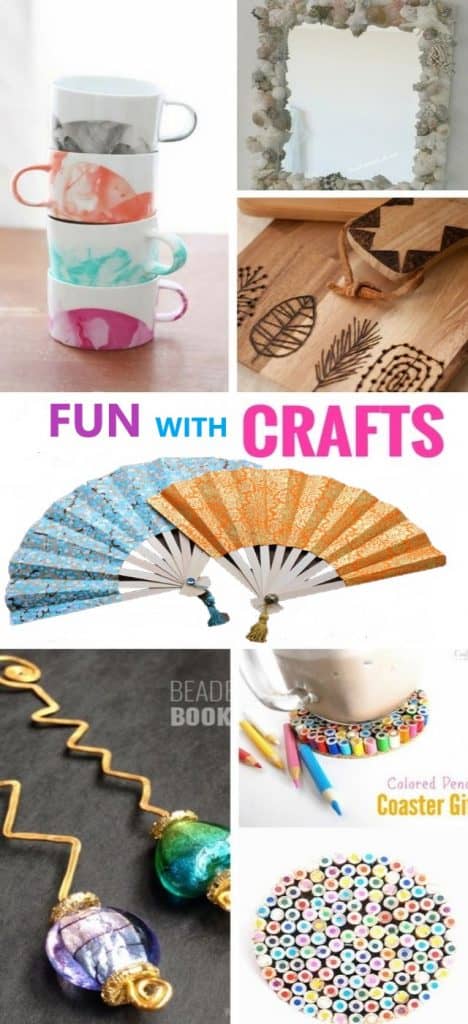
Crafts
Life can be stressful and leaves many people looking for ways to reduce stress and search for ways to calm ourselves. Many people find that exercise, pets and meditation but have you ever thought about crafting? Crafting can create a wonderful outlet that anyone can do that can help reduce stress. We narrowed down four ways that crafting can reduce stress and help you feel more relaxed.
Gives a New Focus
When starting a new project you start to take your focus away from your daily tasks. It allows you to take your energy and refocus on what matters at the moment. Be sure to be in a space where you can direct all of your focus on the craft at hand. Any distractions can break your relaxation groove and break focus. Try some fun crafts to do with a hot glue gun, then add a personal touch by using your favorite colors. Just remember to maintain your focus and most of all- have fun!
Increases Confidence
Crafting is an art form and there is no wrong way to create art-despite what some may think. Try something new! You most likely will surprise yourself how talented you are. Don’t forget that practice makes perfect and each time you craft, your skills will be more refined. The key is not to keep your incredible work to yourself. Be sure to show friends and family your finished project. They will love to see the amazing things you can make at home any compliments will boost your crafting confidence.
Provides a Creative Outlet
A creative outlet can give you the much needed opportunity to express yourself. If you are sad you may choose darker colors to craft with thus alleviating the sad feeling. By the end of project you will feel renewed and ready to tackle anything! Sometimes a creative outlet and help without you even realizing it is.
Boosts Social Skills
Crafting is a popular activity and it not only inspires those who craft but also inspires crafters to reach out and engage with each other. Friendships or even craft club ideas can come out of engaging with other who share your same interest. No doubt that there will be other people who find creating something a solution for stress and anxiety.
www.countryliving.com/diy-crafts/
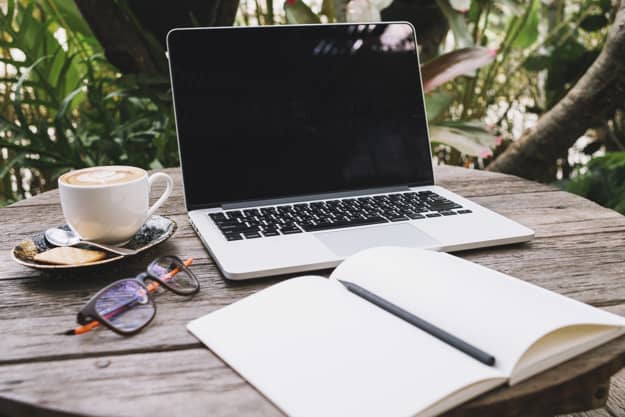
Journaling
To improve your mood and feel a little more relaxed, try incorporating this stress-relieving hobby into your weekly schedule. Multiple studies show that keeping a journal can help reduce stress as well as symptoms of anxiety and depression. Writing down your thoughts helps you clarify your thoughts and emotions and reflect on your feelings, all in a healthy manner. “The advantages of writing is that there are no rules,” says Rebecca Lee, registered nurse. “It just provides a creative way to privately express your thoughts and emotions.”…Not to mention process our experiences!
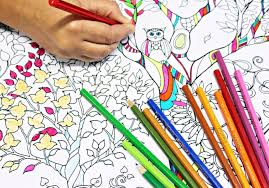
Coloring for Adults
Adult coloring books have been all the rage recently, and for good reason. Many studies show that art therapy is successful at reducing distress, and it can also help with symptoms of anxiety and depression, according to Medical Daily. Using a coloring book elicits a relaxing mindset similar to meditation, as it allows the brain to switch off your thoughts and focus just on what you’re doing in the moment.

Reading a Book
You’ve heard it all before: the most successful people in the world are all avid readers. And countless studies show that reading strengthens brain functions, improves health, reduces stress, makes us more empathetic, and boosts our overall happiness.
But, despite all the benefits listed above, most people can’t be bothered to pick up a book and read what it says. Be different! Make the local library or bookstore your new hotspot. Read both fiction and non-fiction. It really is one of the most productive hobbies out there.

Learn to play an Instrument
Do you play an instrument? Do you want to? Now’s the perfect time. Playing an instrument has a tremendous effect on brain function. Musicians have been linked to higher academic scores, improved memory and better abstract reasoning skills.
But that’s not all. Honing your musicianship can also make you feel less stressed, be more creative and patient, and have more confidence. So break out the ol’ six string or pull up a chair and tickle those ivories. or how about that old harmonica? You won’t regret choosing music as one of your productive hobbies.

Learn a new Language
Speaking multiple languages looks great on a resume and will definitely come in handy when traveling. This is amazing on our most productive hobbies list.
Learning a new language will help you stave off Alzheimer’s and dementia, improve your memory and decision-making skills, and make you more perceptive. True story. So pick a language and start studying.

Sewing to relieve Stress
Sewing encourages mindfulness and reduces stress and anxiety. The meditative action of sewing encourages positivity and feelings of relaxation. Being forced to concentrate on one particular task enables you to become immersed in a situation and truly unwind…
Sewing for Stress Relief: How the Hobby Can Make You Happier…
Sewing is more than just a way to pass the time. This activity also comes with a number of powerful mental and physical health benefits that anyone can experience, whether they’re only a beginner or an expert. Picking up sewing as a hobby can help to improve hand-eye coordination, enhance creativity, relieve pain, and promote brain growth. However, one of the most notable advantages of sewing on a regular basis is relief from stress and anxiety.
The simple act of sewing can work wonders in terms of decreasing your stress levels and boosting happiness and relaxation. Whether you’re going through a particularly stressful period in your life or suffer from chronic stress and anxiety, give yourself a chance to experience the benefits of using the best sewing machine for beginners. Here are some of the main ways in which sewing can help to relieve anxiety and stress.
Sewing Redirects Your Focus
Stress or anxiety often develops as a result of excessive rumination, or the act of repeatedly going over the same thoughts. By focusing exclusively on the negative aspects of a situation, those who struggle with stress and anxiety may end up creating problems that don’t exist.
Sewing helps to combat rumination by allowing you to turn your attention towards something more productive. Instead of stressing about something that went wrong the other day, you can simply sit at your sewing machine for beginners and dedicate yourself to your sewing job. Your problems may suddenly seem a lot smaller once you let yourself engage in a calming activity.
Sewing Boosts Your Mood
When you engage in activities that you enjoy, your brain responds by producing dopamine, a neurotransmitter responsible for feelings of happiness. Finding joy in sewing helps to boost your levels of dopamine, which can contribute to your overall happiness in the long term. While you can experience these benefits whenever you decide to sew, the effects become much more pronounced if you practice sewing on a regular basis. Do your mental health a favor and incorporate more time at your sewing machine for beginners into your schedule, especially when you’re particularly stressed or anxious.
Sewing Lets You Unplug
In today’s society, we’re constantly bombarded with various forms of technology. Whether you’re texting a friend on your phone or browsing new shoes on your laptop, it’s difficult to escape the nonstop stimulation. Fortunately, sewing provides a healthy outlet where you can express your creativity and enhance your motor skills without the harmful glow of a screen. Unplugging from electronics is also crucial when you have a hectic work schedule and need some valuable downtime. By focusing on the intricate movements involved in sewing, you can let your brain relax.
Sewing Allows You To Focus On One Thing At A Time
When you regularly deal with a packed schedule, multitasking becomes second nature. Doing more than one thing at a time is often the only way to cope with the constant demands of daily life. However, there are many negative effects of multitasking that can hurt your productivity and well-being in the long run. To effectively shift your focus to a single task, make a conscious effort to use your sewing machine for beginners on a regular basis.
Not only can giving up multitasking help to decrease stress and anxiety, but it also helps you tune in to all of your senses and live in the moment. Once you’re truly focused on the present, you no longer have to worry about what awaits you in the future, which is typically a major source of anxiety. Additionally, simply having a moment to yourself is rare in this fast-paced world. Sewing has the power to grant you the valuable quiet time that you need.
Sewing Gives You A Sense Of Accomplishment
Sewing can be difficult at first, but with enough practice, you can replace your sewing machine for beginners with a more advanced tool. This very act of improving and learning as much as you can about the sewing process instills a deep sense of accomplishment inside you. Whether you repair a favorite sock that would have been tossed otherwise, create a jacket or a dress, or make a quilt masterpiece, sewing provides you with concrete evidence of the difficulties you overcame and the essential skills you developed. If you regularly struggle with anxiety or stress, you can use this newfound sense of confidence and self-reliance to help boost your spirit.
Becoming Your Best Self
By adopting sewing as a new hobby, you can discover a newer and better side of yourself. Remember to be patient with yourself and start out slow as you learn all the ropes of sewing. Once you’ve spent enough time working on your sewing machine for beginners, you may start to notice a meaningful difference in your mental health and well-being.
www.reviewthis.com/how-sewing-can-relieve-stress-anxiety/